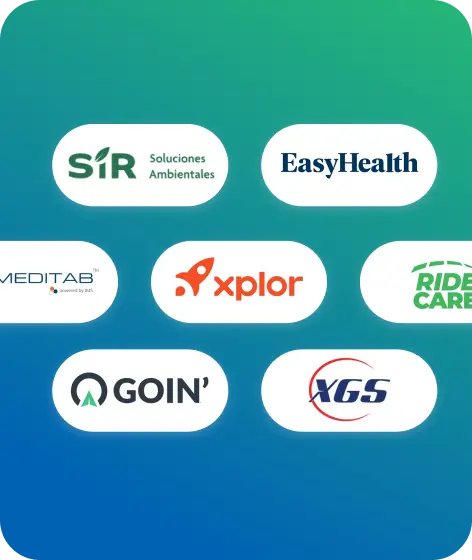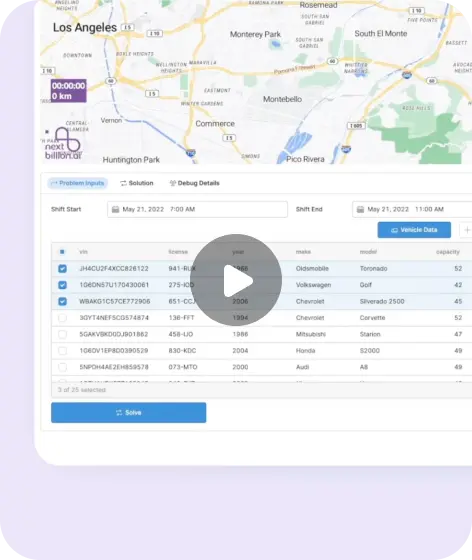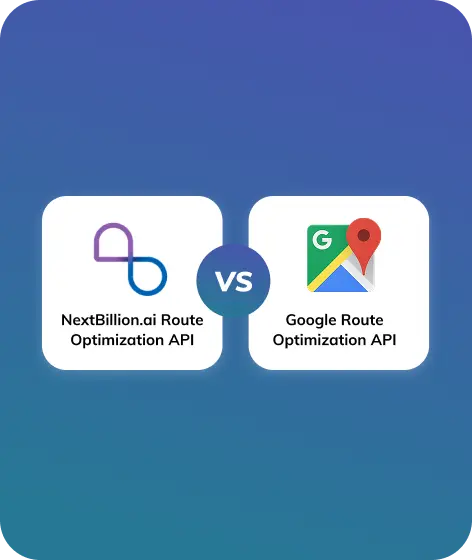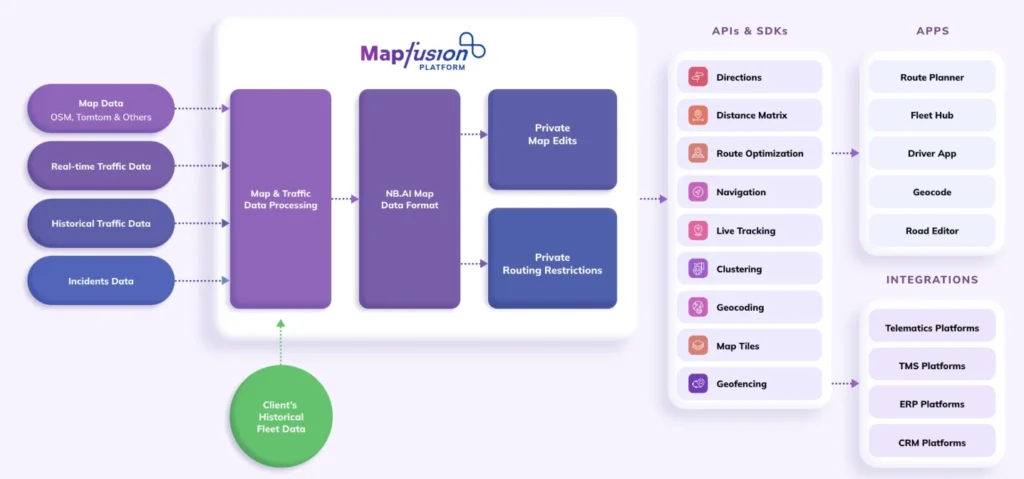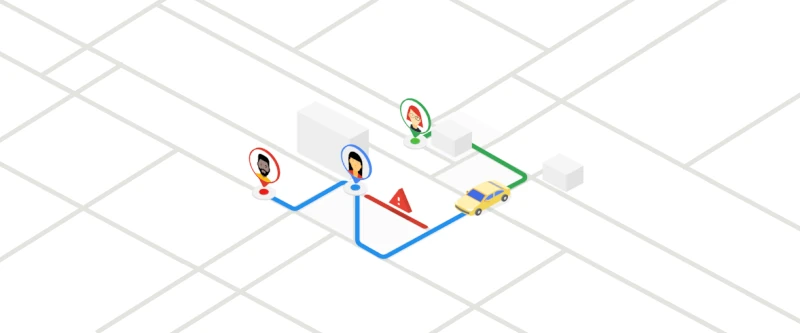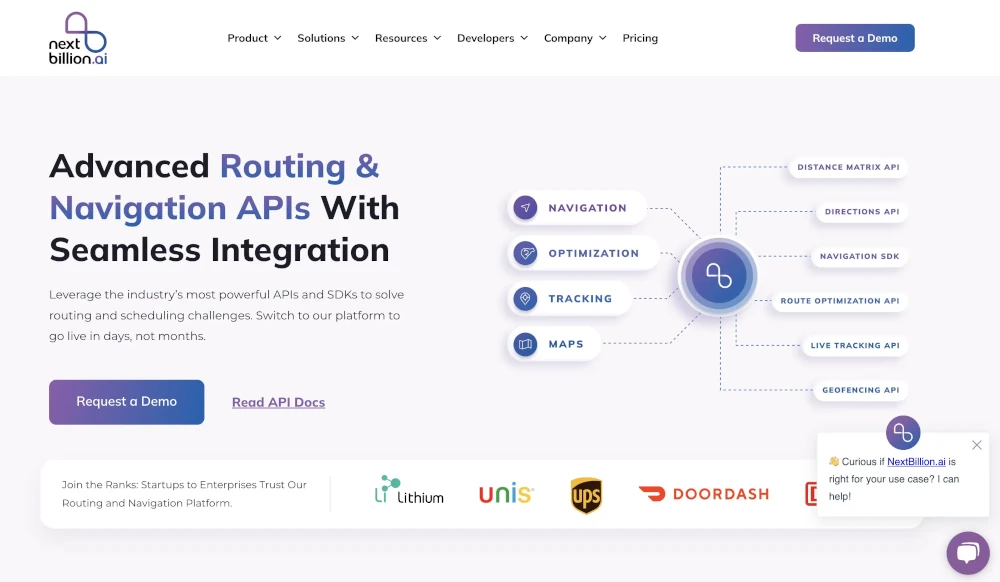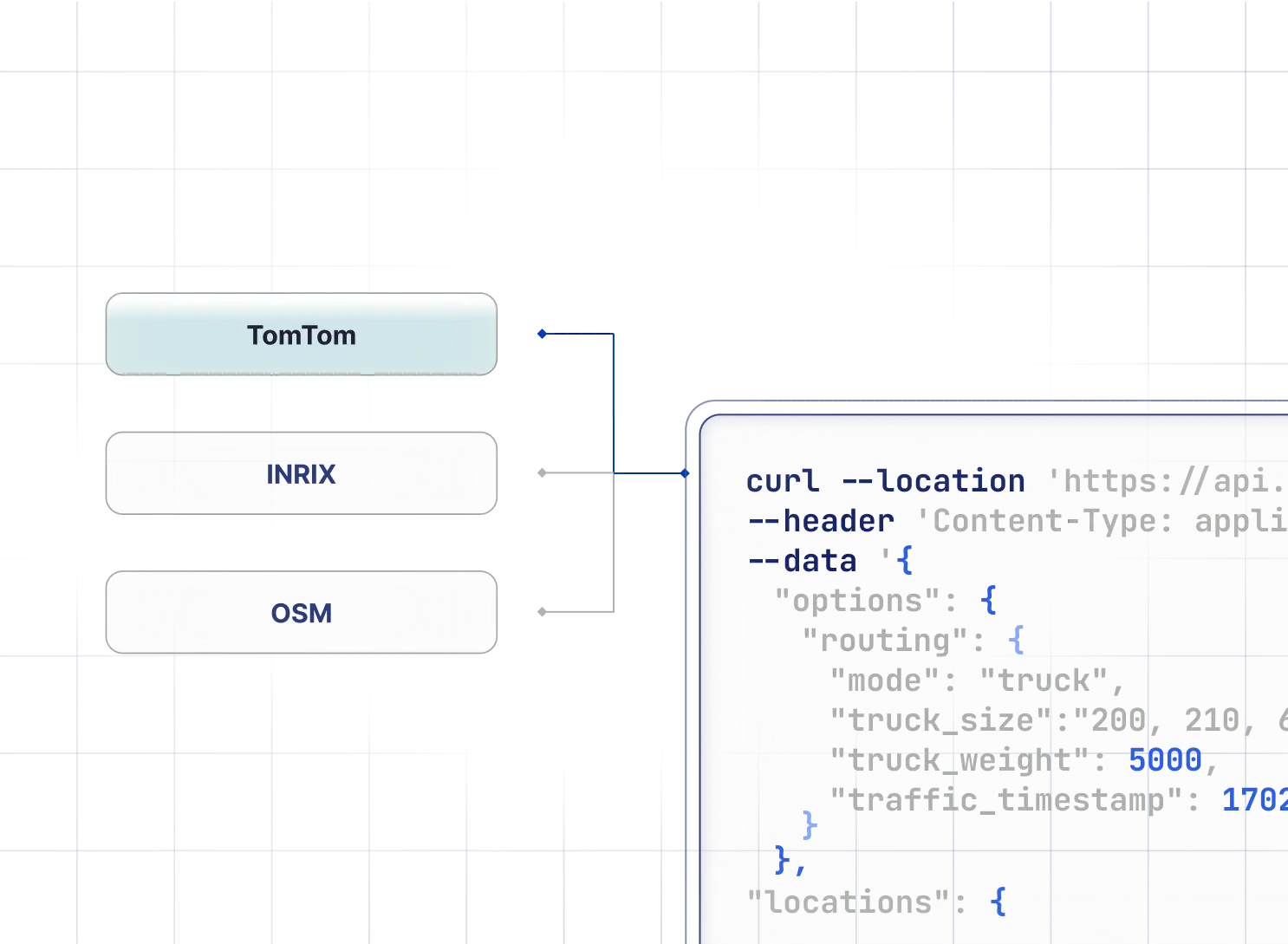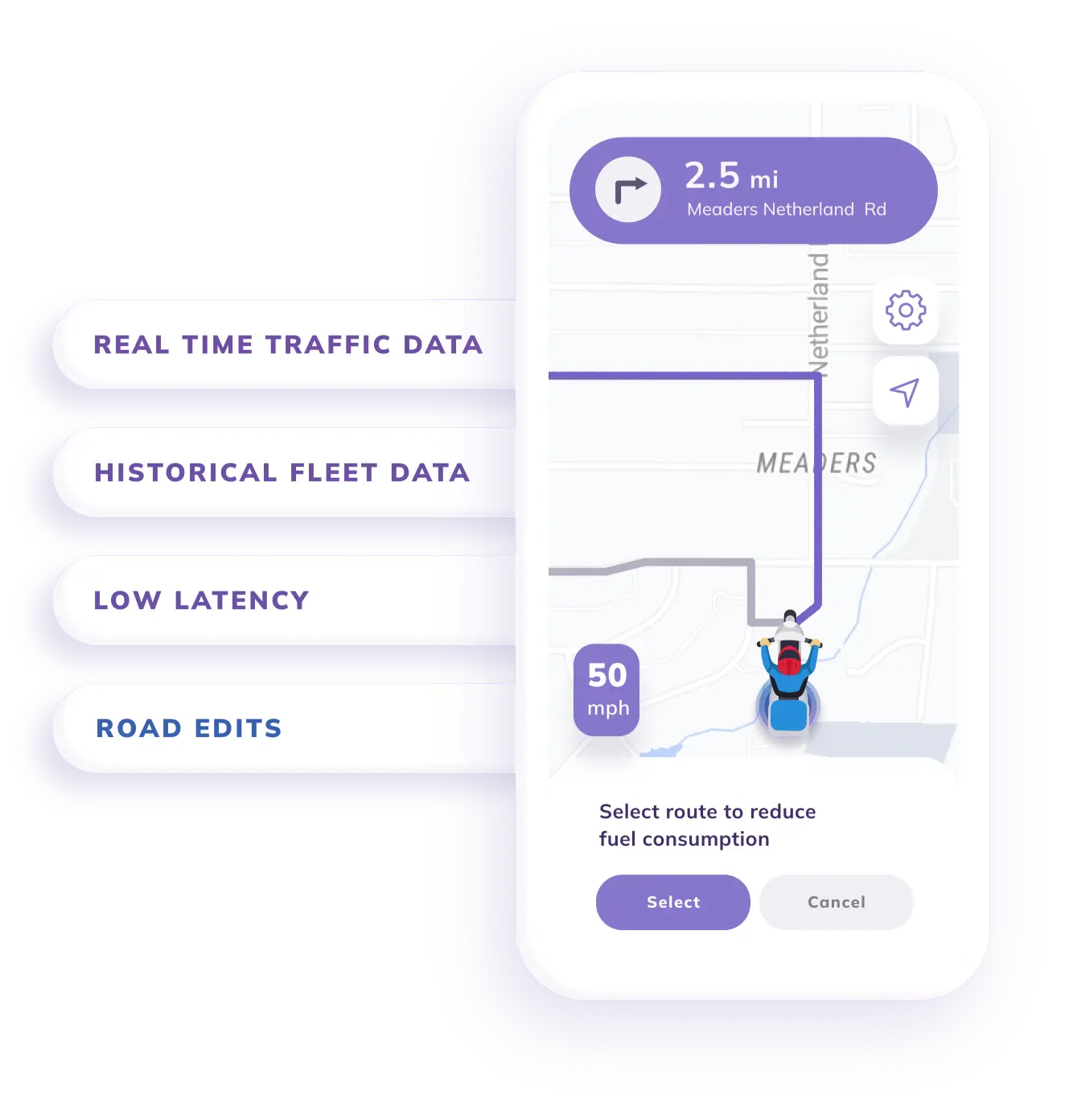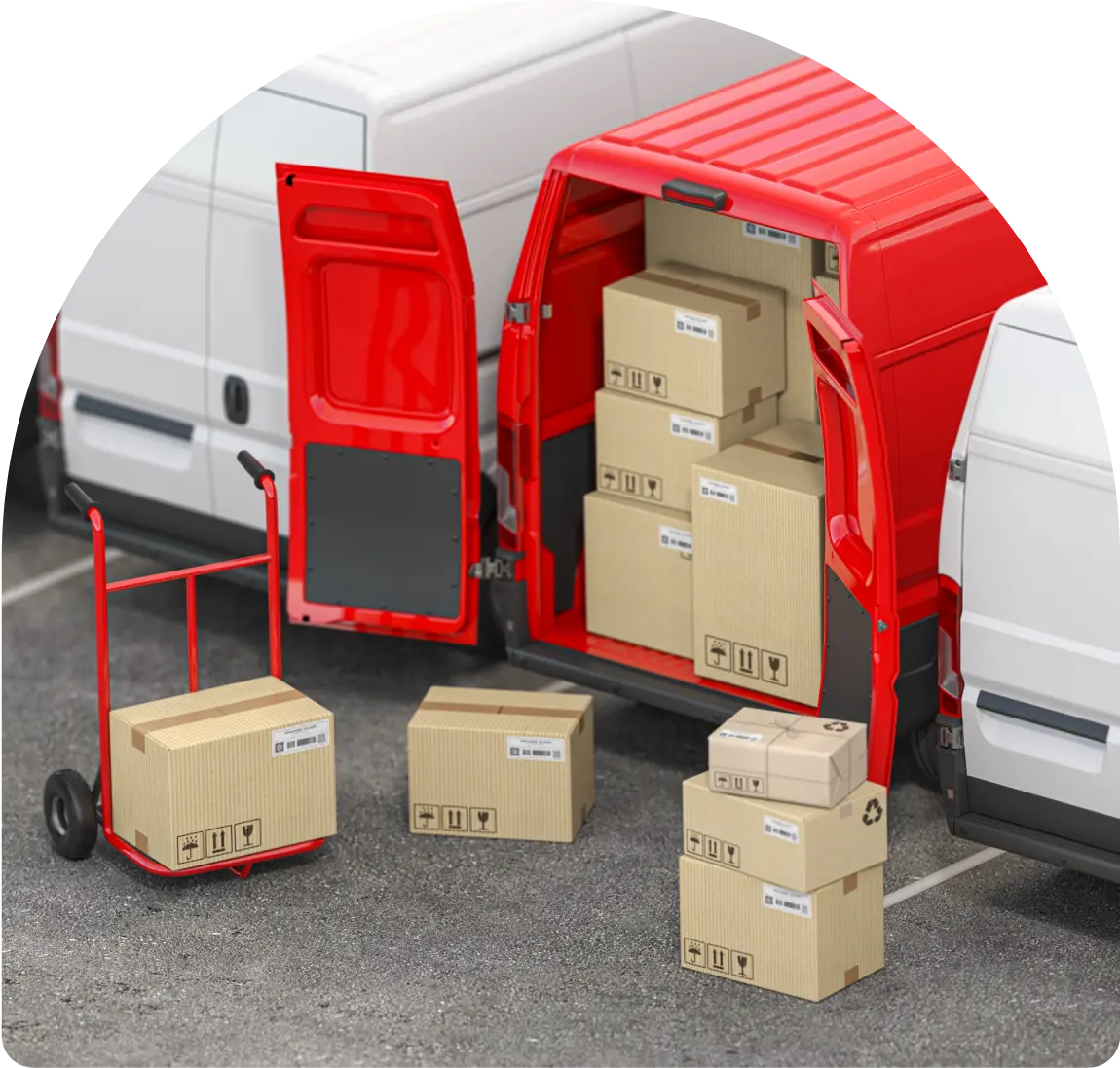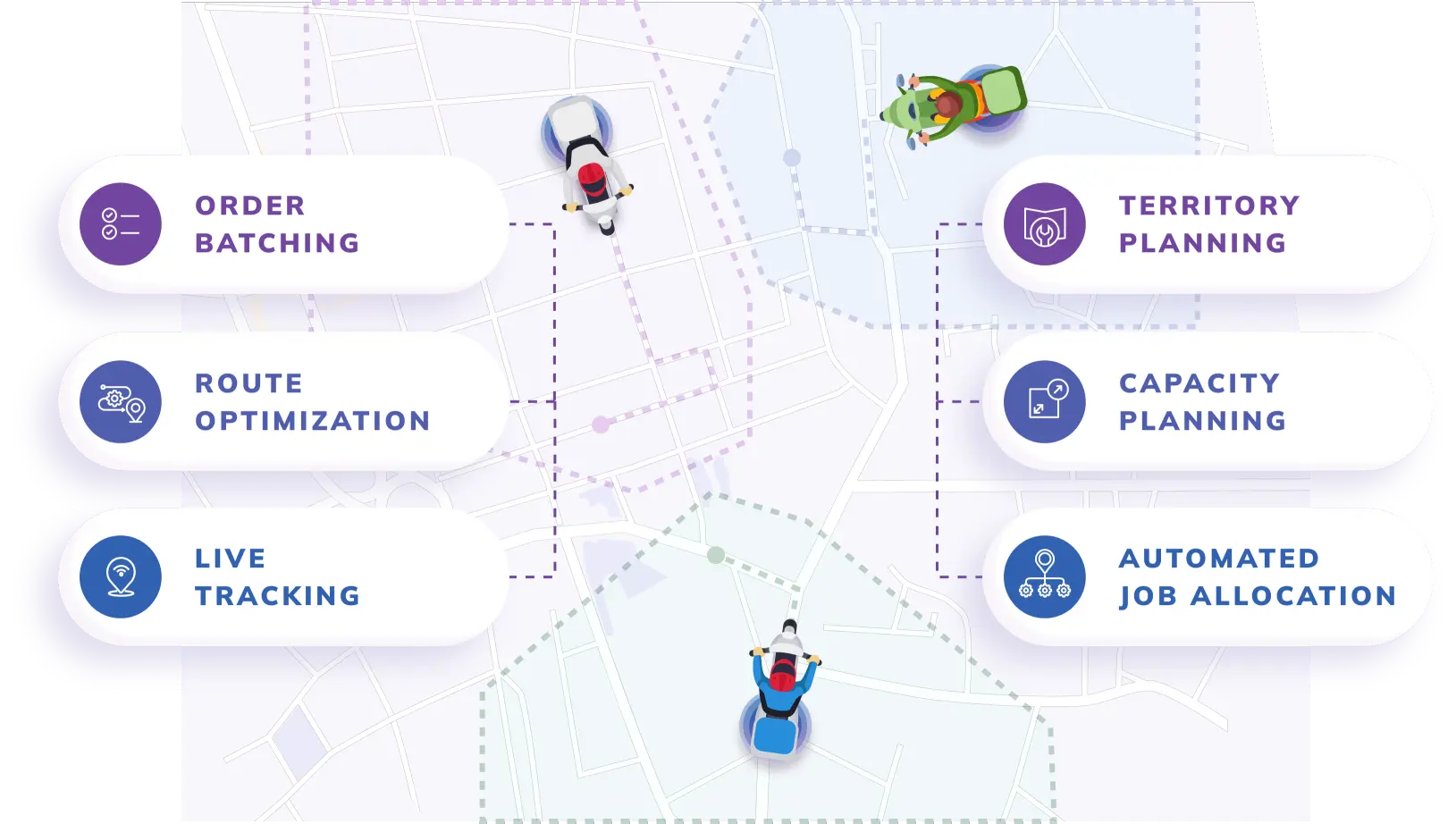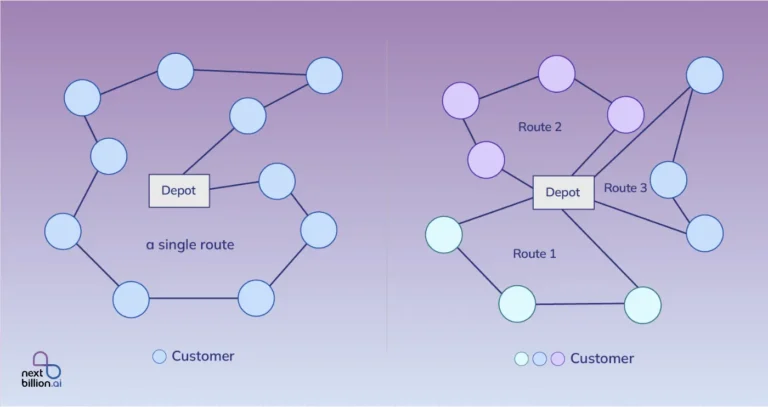
Table of Contents
The on-demand economy has transformed the way people move and receive deliveries. On-Demand Ride & Delivery (ODRD) solutions power ride-hailing services, food and grocery deliveries, courier businesses, and more. These solutions rely on real-time routing, accurate ETAs, and efficient fleet management to ensure seamless customer experiences.
As demand for faster and more efficient services grows, businesses need ODRD solutions that are scalable, cost-effective, and highly customizable. Standard mapping APIs may not always provide the flexibility required for industry-specific routing needs. Factors like traffic conditions, local road restrictions, vehicle types, and delivery priorities must be considered for optimal performance.
Two leading ODRD solutions in the market are Google Maps and NextBillion.ai. Google Maps is widely recognized for its global coverage and reliable navigation, making it a go-to choice for businesses needing a ready-to-use solution. However, its high API costs and limited customizability can be challenges for businesses looking for more tailored routing. NextBillion.ai, on the other hand, offers a more flexible and cost-efficient alternative, allowing companies to customize routing, integrate multiple map sources, and optimize based on their specific needs.
In this article, we will compare Google Maps vs. NextBillion.ai ODRD solutions, evaluating key features such as routing accuracy, customization, scalability, cost, and overall efficiency. By the end, you’ll have a clear understanding of which solution best fits your business needs.
What is an ODRD Solution?
On-Demand Ride & Delivery (ODRD) solutions enable businesses to efficiently manage and optimize real-time transportation, whether for ride-hailing, food delivery, parcel shipping, or logistics operations. These solutions integrate mapping, routing, and dispatching technologies to connect drivers and couriers with customers in the most efficient way possible.
An ODRD solution is based on real-time routing, ETA accuracy, cost efficiency, and scalability:
- Real-Time Routing: Ensures drivers take the fastest and most optimal route, adjusting dynamically to traffic conditions, road closures, and customer locations.
- ETA Accuracy: Provides reliable estimated arrival times, improving customer satisfaction and fleet coordination.
- Cost Efficiency: Reduces fuel consumption, idle time, and operational costs by optimizing routes and driver assignments.
- Scalability: Supports business growth by efficiently handling increasing ride and delivery requests without performance drops.
ODRD solutions are essential in industries where speed, efficiency, and reliability are key. Some of the major sectors that rely on ODRD technology include:
- Ride-Hailing & Mobility Services: Apps like Uber, Lyft, and local ride-sharing platforms use ODRD to match riders with nearby drivers efficiently.
- Food & Grocery Delivery: Services like DoorDash, Uber Eats, and Instacart depend on ODRD for fast order fulfillment and optimized delivery routes.
- Parcel & Last-Mile Logistics: Couriers and e-commerce businesses (e.g., Amazon, FedEx) use ODRD for timely package deliveries.
- Healthcare & Emergency Services: Medical transport and urgent deliveries rely on real-time routing for time-sensitive operations.
As demand for on-demand transportation and delivery continues to rise, businesses must adopt high-performing ODRD solutions to remain competitive. Choosing the right platform can impact efficiency, customer satisfaction, and operational costs.
How an ODRD Solution Works?
Before we start with the comparison, let us understand the workings of an ODRD solution. An On-Demand Ride & Delivery (ODRD) solution relies on a combination of map data, traffic insights, routing intelligence, and real-time tracking to efficiently match drivers with customer requests. Here’s how the process works using NextBillion.ai’s MapFusion platform as a reference:
1. Data Ingestion & Processing
The system integrates multiple data sources to build an intelligent routing framework:
- Map Data (e.g., OSM, TomTom) provides base navigation and road network details.
- Real-Time Traffic Data ensures drivers take the fastest available routes.
- Historical Traffic Data refines ETA accuracy by considering past congestion patterns.
- Incidents Data (road closures, accidents) helps in dynamic rerouting.
- Client’s Historical Fleet Data enhances route planning based on past trips and fleet performance.
All this data is processed into the NextBillion.ai Map Data Format, ensuring customization and private control over routing rules.
2. Customization for Business Needs
Once the data is processed, businesses can customize it using:
- Private Map Edits – Modify road conditions, adjust speed limits, or add custom locations.
- Private Routing Restrictions – Enforce vehicle-specific constraints like turn restrictions, toll avoidance, or restricted zones.
This ensures that the ODRD system aligns with business-specific routing needs, optimizing efficiency.
3. Intelligent APIs & SDKs for Real-Time Operations
The core ODRD system then uses various APIs and SDKs to power on-demand operations:
Directions API – Provides optimized navigation for drivers.
Distance Matrix API – Calculates trip times and assigns the nearest drivers.
Route Optimization API – Determines the most efficient multi-stop routes.
Live Tracking API – Tracks driver movement in real-time.
Geofencing API – Restricts or prioritizes service zones.
These APIs work together to match riders with the nearest available driver, optimize pickup/drop-off points, and dynamically adjust ETAs based on real-world conditions.
4. End-User Experience: Apps & Interfaces
The ODRD system powers various applications for different stakeholders:
Route Planner – Helps dispatch managers optimize fleet movements.
Fleet Hub – Centralized dashboard for managing driver availability & assignments.
Driver App – Provides navigation, task updates, and optimized routes to drivers.
Geocode & Road Editor – Allows businesses to refine location accuracy and road conditions.
5. Seamless Integrations for Scalability
To fit into existing business ecosystems, the ODRD solution integrates with:
Telematics Platforms – Monitors vehicle health & driver behavior.
TMS, ERP, & CRM Platforms – Syncs with fleet management, order processing, and customer databases.
6. End-to-End ODRD Flow
- A customer requests a ride/delivery.
- The system geocodes the request and finds the optimal driver.
- Real-time traffic & route optimization APIs generate the fastest route.
- The driver receives the trip assignment via the Driver App.
- The fleet manager monitors the trip using the Fleet Hub.
- The Live Tracking API updates ETAs and manages delays dynamically.
- Upon completion, trip data is stored for future optimization & reporting.
With its customizable routing, real-time optimizations, and enterprise-ready integrations, NextBillion.ai delivers a powerful ODRD solution for businesses looking to scale efficiently.
Google Maps ODRD Solution
Google Maps has been a leading provider of On-Demand Ride & Delivery (ODRD) solutions, offering businesses access to its powerful mapping, routing, and navigation APIs. Its suite of services—including Maps, Directions, Places, and Geocoding APIs—makes it a popular choice for companies looking for a reliable, globally recognized solution.
Key Features
Global Coverage with Detailed Maps
Google Maps offers extensive global coverage, ensuring businesses can operate across multiple regions with highly detailed and accurate location data.
Pre-Built Solutions with Easy Integration
Google’s ODRD APIs are plug-and-play, allowing businesses to integrate real-time routing, navigation, and location tracking without building custom mapping solutions.
Google’s Ecosystem
Businesses benefit from a seamless integration with Google’s suite of APIs, including:
- Google Maps API (visual mapping and location display).
- Directions API (route planning and turn-by-turn navigation).
- Places API (address search, business locations, and POI data).
- Geocoding API (converting addresses into coordinates).
Real-Time Traffic Updates
Google Maps provides live traffic data to help optimize routes and adjust ETAs dynamically based on congestion, road closures, and other delays.
Limitations of Google Maps ODRD Solutions
High API Costs for Scaling Businesses
Google Maps charges based on API usage, making it an expensive solution for businesses handling high-volume ride or delivery operations. Costs can quickly escalate, especially for startups or companies expanding their fleet.
Limited Customizability for Specific Business Needs
While Google Maps offers robust pre-built solutions, it lacks the flexibility for businesses that need custom routing logic (e.g., industry-specific optimizations for logistics, ride-sharing, or hyperlocal delivery).
Less Flexibility in Handling Unique Routing Constraints
Google Maps follows standard traffic-based routing, but it does not allow advanced customization for vehicle-specific restrictions, road usage policies, or local regulations (e.g., restrictions for electric vehicles, hazardous materials, or weight limits).
NextBillion.ai ODRD Solution
NextBillion.ai provides a highly customizable On-Demand Ride & Delivery (ODRD) solution designed for businesses that require flexible, scalable, and cost-effective routing. Unlike traditional mapping providers, NextBillion.ai allows companies to integrate multiple map sources, fine-tune routing algorithms, and optimize operations based on their unique needs.
Key Features
NextBillion.ai offers the following key features.
Multi-Source Map Integration
One of the biggest advantages of NextBillion.ai’s ODRD solution is its ability to integrate multiple map sources, giving businesses unmatched control and accuracy over their routing. Unlike traditional ODRD solutions that rely on a single mapping provider, NextBillion.ai enables companies to combine different map data sources and customize routing based on their specific operational needs.
How Does It Work?
Feed in the Most Suitable Map Using NextBillion.ai’s Map Reader
Businesses can choose the best map for their region and fleet instead of being locked into a single provider. NextBillion.ai’s map reader allows integration of different map sources, ensuring better local accuracy and reliability. The system can be informed by past trip data and speed profiles, leading to more precise ETAs and distance calculations.
Supported Map Data Sources
- TomTom – Commercial-grade mapping with global coverage.
- OpenStreetMap (OSM) – Open-source and community-driven map data.
- Your Past Trip Data – Leverage historical trip records to refine routes.
- INRIX – Real-time and predictive traffic data for better routing decisions.
- TomTom – Commercial-grade mapping with global coverage.
- Define Routing Preferences Using Road Editor
Businesses can use NextBillion.ai’s road editor to customize routing rules:
- Enforce turn restrictions to prevent unsafe or illegal maneuvers.
- Mark hazardous areas, road closures, or construction zones to minimize detours and surprises.
- Fine-tune routes to reduce operational costs and travel time.
3. Map-Agnostic Architecture for Maximum Flexibility
- NextBillion.ai’s map-agnostic approach means businesses are not tied to a single provider.
- Companies can mix and match data sources based on their region, use case, and cost considerations.
- Whether using open-source, commercial, or proprietary maps, businesses can adapt their routing strategy dynamically.
- NextBillion.ai’s map-agnostic approach means businesses are not tied to a single provider.
Why This Matters for ODRD Businesses?
- Improved Accuracy: Use the most relevant map and traffic data for each region.
- Cost Savings: Reduce API expenses by selecting more affordable data sources where applicable.
- Operational Control: Customize routing rules to avoid inefficiencies, delays, and unnecessary costs.
Order Grouping: Smarter Task Consolidation for Drivers
In ODRD operations, drivers often handle multiple pickups or deliveries within close proximity—such as in apartment buildings, gated communities, or business complexes. Instead of treating each request as a separate stop, NextBillion.ai’s Order Grouping feature consolidates them into a single stop, streamlining the driver’s route and minimizing unnecessary detours.
How Order Grouping Works:
- Businesses can set a configurable diameter to group multiple tasks that fall within a defined range.
- The system treats all tasks within this range as a single stop, reducing the number of times a driver needs to find parking or stop unnecessarily.
- Particularly useful in condos, corporate offices, or housing complexes, where multiple orders can be picked up or dropped off at a single designated point.
ODRD Benefits of Order Grouping:
✔ Reduces stop frequency → Less time wasted on redundant stops.
✔ Improves driver efficiency → Fewer detours and better task consolidation.
✔ Saves parking & waiting time → Drivers don’t have to park multiple times at close locations.
✔ Enhances customer experience → Faster and more organized deliveries.
For businesses handling high-volume deliveries or ride pooling, order grouping leads to smoother, faster, and more fuel-efficient operations.
Zone-Based Allocations: Intelligent Driver & Vehicle Dispatching
Zone-Based Allocations ensure that vehicles are assigned to specific zones, preventing inefficiencies like overlapping coverage, unnecessary long-distance trips, and driver unfamiliarity with local areas.
How Zone-Based Allocations Work:
- Businesses can define operational zones for vehicles and drivers.
- These zones can be:
- Manually configured during route planning.
- Dynamically set using NextBillion.ai’s Geofence API.
- Manually configured during route planning.
- The system allows or restricts certain vehicles from entering specific zones, ensuring optimal coverage and balanced workloads.
ODRD Benefits of Zone-Based Allocations:
✔ Minimizes route inefficiencies → Avoids vehicles taking unnecessary long routes.
✔ Prevents overlapping coverage → Ensures drivers operate efficiently within their designated areas.
✔ Leverages driver expertise → Assigns drivers to neighborhoods they are familiar with, improving navigation and service speed.
✔ Enhances fleet utilization → Helps balance workload across different service zones.
For on-demand businesses like ride-hailing, food delivery, and courier services, this feature ensures that drivers stay within strategic coverage zones, optimizing availability and improving overall service reliability.
Geospatial Intelligence for Hyperlocal Accuracy
Provides enhanced location intelligence to improve address matching, geocoding, and route precision.
Helps businesses refine local operations in areas where traditional mapping services might be less accurate.
Scalability & Flexibility for Unique Routing Needs
NextBillion.ai’s ODRD solution is designed to handle complex dispatching scenarios and to scale effortlessly as your business expands. This flexibility ensures that your operations can adapt to the evolving demands of diverse markets and intricate routing challenges. Here’s how it addresses these needs:
- Multi-Stop Routing:
The platform supports complex journeys that involve multiple stops, enabling efficient route planning for deliveries and pickups that require several sequential visits. This capability minimizes overall travel time and operational costs. - Driver Priority Assignments:
NextBillion.ai allows you to assign tasks based on driver priorities. Whether it’s prioritizing experienced drivers for challenging routes or allocating tasks based on proximity, the system helps optimize resource deployment in real time. - Service Area Constraints:
The solution can enforce geographical service boundaries, ensuring that dispatches occur only within predefined areas. This is particularly useful for businesses operating in regions with strict local regulations or specific market zones.
Robust Dispatch Management Features
NextBillion.ai also offers advanced dispatching capabilities. The following features stand out the most.
Automate Slot Scheduling
The platform streamlines planning by automating slot scheduling. This not only prevents scheduling errors but also enhances resource efficiency by ensuring that every available slot is optimally utilized, reducing downtime and improving overall productivity.
Time-Window Management
To guarantee timely deliveries, NextBillion.ai balances urgent and non-urgent tasks effectively. By managing time windows for each delivery or pickup, the system ensures that high-priority tasks are completed on time, thus reducing delays and increasing customer satisfaction.
Accommodate Last-Minute Changes
In the dynamic world of on-demand services, unexpected events like breakdowns or cancellations are common. NextBillion.ai’s dynamic route generation can quickly adapt to these last-minute changes, recalculating routes in real time to minimize disruptions and maintain service reliability.
Cost-Effective API Pricing
Offers a more affordable alternative to Google Maps, making it ideal for companies handling high-volume routing and dispatching.
Transparent pricing structure that scales with business growth.
Advantages of NextBillion.ai’s ODRD Solution
- Supports custom map layers and historical data.
- Supports multi-source map integration like OSM, Tomtom, INRIX and private fleet data.
- Offers route optimization based on business-specific constraints.
- Seamless enterprise integration supports ERP, Telematics and CRM integrations.
More affordable for high-volume API requests.
Final Verdict: Which ODRD Solution is Right for Your Business?
Based on the comparison, Google Maps is ideal for basic ride-sharing and delivery but lacks deep customization, advanced routing constraints, and cost efficiency for high-volume businesses.
On the other hand, NextBillion.ai offers superior routing flexibility, real-time adaptability, large-scale optimization, and cost savings, making it a better choice for businesses needing scalable, industry-specific ODRD solutions.
Below is a detailed comparison table that you can use while making a choice for your business.
Criteria | Google Maps | NextBillion.ai |
Routing Accuracy | High but generic | High with industry-specific customization |
Customization | Limited; lacks control over industry-specific needs | Fully customizable with modular routing and fleet optimization |
Traffic Data | Real-time | Real-time + historical insights |
Multi-Source Mapping | No | Yes (Map agnostic architecture, supports multiple data sources) |
Support for Hyperlocal Data | Limited | Extensive, with geofencing, road closures, and custom map overlays |
Global Address Coverage | Extensive database for worldwide use. | Customizable but limited global reach. |
Advanced Routing | Basic multi-stop routing with a 25-waypoint limit. | Supports 200+ waypoints, advanced sequencing, and 50+ constraints. |
Navigation | Built-in turn-by-turn guidance. | SDK-based integration for custom navigation. |
Trip Tracking & Notifications | Pre-built real-time tracking & alerts. | Customizable via event-based triggers. |
Fleet Optimization | Basic optimization for ride-sharing & delivery. | Advanced fleet engine with better dispatching, lower latency, and high-throughput routing. |
Scalability & Performance | Limited efficiency in handling large-scale routing; latency issues in large matrix calculations. | Compute large matrices (5000×5000) in seconds; lower latency and higher throughput for high-volume applications. |
Real-Time Adaptability | Standard traffic-based routing. | Dynamically adapts to real-time traffic with advanced vehicle-specific routing (bikes, e-scooters, autonomous vehicles, etc.) |
Cost Efficiency | Expensive pay-as-you-go model with high cloud costs. | Flexible pricing based on unique stops, vehicles, and API calls; optimized for cost savings. |
Support & Reliability | Standard, unresponsive, slow issue resolution. | Dedicated solutions engineers, quick response times, and superior product support |
Choose Google Maps If:
✔️ You need a plug-and-play solution with extensive global coverage.
✔️ Automated driver assignment and dispatch is a priority.
✔️ You require native turn-by-turn navigation within the app.
Choose NextBillion.ai If:
✔️ You need custom routing solutions for specific industries (e.g., logistics, hyperlocal deliveries).
✔️ Cost efficiency is a major concern for large-scale API usage.
✔️ You require more control over driver search, trip tracking, and notification triggers.
Both Google Maps and NextBillion.ai offer robust ODRD solutions, but the best choice depends on business needs, budget, and level of customization required. If you need a ready-to-use global solution with strong automation, Google Maps is a great option. However, if you’re looking for a cost-effective, flexible, and customizable ODRD solution, NextBillion.ai is the better choice.
Reduce your Google ODRD Bill by 30% with NextBillion.ai.
About Author
Shivangi Singh
Shivangi is a seasoned Technical Writer with a passion for simplifying technical concepts. With over 5 years of experience, she specializes in crafting clear and concise documentation for various technical products and platforms.

